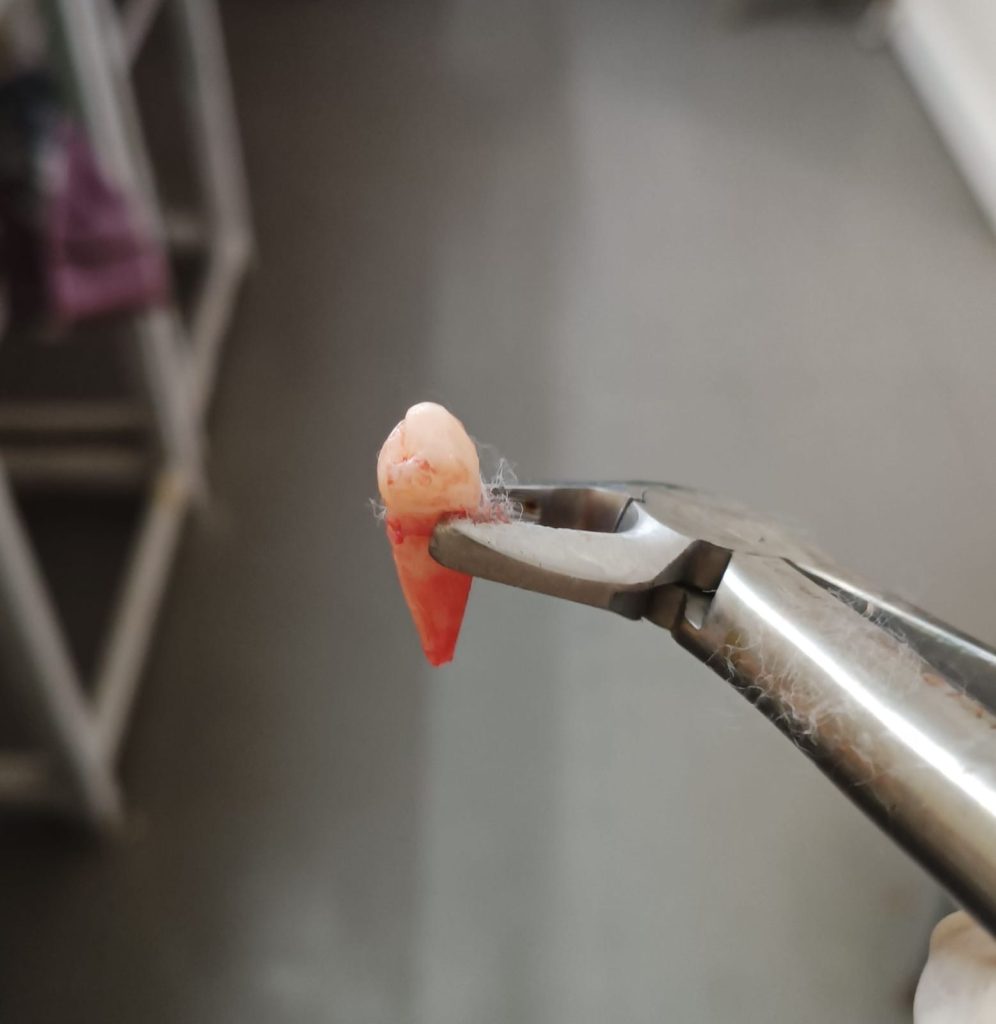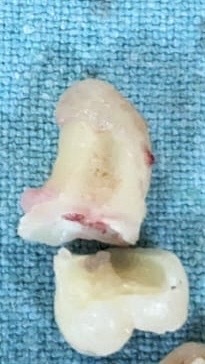As a dentist, I often see my patients’ faces filled with concern when we discuss the possibility of tooth extraction. It’s understandable; having a tooth removed can be terrifying. However, understanding the specifics of the procedure can significantly reduce anxiety and help you feel more prepared.
Dentistry primarily has two types of tooth extractions: simple and surgical. Each type is designed for specific situations, from a straightforward removal of a visible tooth to more complex cases requiring surgical intervention. Confused by their options, many patients ask, “What’s the difference between simple extraction and surgical extraction?” when discussing tooth removal. My goal today is to guide you through the differences between these two procedures, offering insights from years of professional experience. Whether you’re out of necessity, curiosity, or concern for a loved one, I’m here to ease your journey through tooth extraction, making the unknown familiar and manageable.
What is Tooth Extraction?
Tooth extraction, also known as “pulling a tooth,” is a dental procedure where a tooth is completely removed from its socket in the jawbone. Even though our top priority is to save natural teeth, there are some conditions where tooth removal is unavoidable. If the damage is minimal, we can save the teeth by doing fillings or Root Canal Treatment, but if the damage is extensive, removing the tooth is the only option for better oral health of the patients.
There are many reasons for tooth removal, including deep decay, infection, severe pain, fractured teeth, and impacted wisdom teeth.
Simple Extraction vs Surgical Extraction.
As mentioned above, there are two types of extraction: simple and surgical. A dentist can decide whether a procedure requires a simple or surgical removal by checking an x-ray and examining the tooth.
Simple Extraction:
Simple or non-surgical extraction is a straightforward procedure that general dentists can perform. It is done on teeth that are fully visible and not buried beneath the gums. This includes teeth that are significantly decayed, damaged, or otherwise compromised and cannot be saved through other dental treatments. Simple extraction may also be done in conditions such as overcrowding, where removing one or more teeth can facilitate alignment and orthodontic treatment.
Procedure Explained:
Simple tooth removal begins with using two key dental instruments: the elevator and dental forceps. The elevator plays a crucial role in loosening the tooth. It gently rocks the tooth back and forth, loosening its connection with the surrounding ligaments and the jawbone. Once loosened, dental forceps come into play, gripping the tooth firmly to facilitate its removal.
During this process, patients may experience a sensation of pressure. This feeling is normal and should not be confused with pain, as the area will be numbed using local anesthesia to ensure comfort throughout the procedure. The goal is to disrupt the periodontal ligament enough to allow the tooth to be lifted out of its socket without causing discomfort.
After removing the tooth, cotton is placed in the socket, and the patient is asked to bite on it. A simple extraction does not usually need sutures, but if the extraction is traumatic, sutures are required. The recovery period is 1-2 days following the simple removal.
Pros:
- Quicker and less complex procedure.
- Usually, local anesthesia is used to numb the area.
- Generally more affordable than surgical extraction.
- Quick recovery period.
Cons:
- It is limited to fully visible and easily accessible teeth.
- Potential for minor complications like root fracture or difficulty removing the tooth.

Surgical Extraction:
Surgical tooth extraction is a complex procedure compared to non-surgical tooth removal. It is a dental procedure to remove a tooth that cannot be easily accessed or removed through simple extraction. This could be due to the tooth being impacted (not fully erupted through the gum), broken off at or below the gumline, or having unusually shaped or positioned roots. This procedure is usually performed by an Oral and maxillofacial Surgeon (a dentist specializing in OMFS) or sometimes by a general dentist with special training in surgical extractions.
Surgical extraction may be necessary in some conditions, including
- Impacted Wisdom Teeth: The most common reason for surgical removal is impacted wisdom teeth, which are unable to emerge normally and can lead to pain, infection, and other dental issues.
- Severely Damaged Teeth: Teeth are severely damaged by decay or trauma, where much of the tooth structure is missing or below the gum line.
- Complex Root Systems: Teeth with long, curved, or entwined roots with the bone or nerves.
Procedure Explained:
The procedure begins with a thorough examination, including X-rays, to assess the tooth’s condition and plan the extraction. Here’s what you can typically expect during the process:
- Anesthesia: Local anesthetic is administered around the tooth to ensure comfort. In some cases, especially for more complex extractions or for patients with dental anxiety, sedation or general anesthesia may be used.
- Incision: A small incision is made in the gum tissue to expose the tooth and bone.
- Removing Bone and Sectioning the Tooth: If necessary, small amounts of bone surrounding the tooth may be removed, or the tooth may be cut into sections to facilitate easier removal.
- Extraction: With precision, the tooth is carefully removed. The goal is to minimize the impact on tissues surrounding the tooth and ensure a smooth recovery.
- Stitches: The area may be stitched to promote healing, often with stitches that dissolve over time.
- Recovery: The recovery period for this procedure is generally 3-10 days.
Pros:
- Can remove impacted, broken, or multi-rooted teeth.
- Offers better access to deeply rooted or partially erupted teeth.
- It can be done under general anesthesia for added comfort.
Cons:
- Longer recovery time compared to simple tooth removal.
- More invasive procedure.
- Higher cost due to the involved procedure.
- Potential for complications like infection, nerve damage, or excessive bleeding.

What to do after extraction:
After dental extraction, whether it is simple or surgical extraction, it’s crucial to follow specific aftercare instructions to ensure proper healing and prevent complications. Here are general guidelines to follow after your tooth extraction:
- Applying ice packs to the area to reduce swelling.
- Taking pain medication as prescribed.
- Avoiding strenuous activity.
- Eating soft foods.
- Do not rinse your mouth for the first 24 hours to avoid disturbing the blood clot.
- Maintaining good oral hygiene by brushing and flossing gently and avoiding the extraction site.
- Do not smoke to reduce the risk of complications.
- Do not use straws.
- Do not spit vigorously.
Conclusion: Extract Wisely: Simple or Surgical?
Choosing between a simple and surgical extraction isn’t a decision you’ll need to make alone. Your dental professional guides you through the process, weighing the specific circumstances of your dental health to recommend the best course of action. Whether your path involves a simple pull or a surgical procedure, the goal remains the same: to relieve pain, prevent further dental complications, and improve your overall oral health. Simple extraction is a quick and straightforward solution for easily accessible teeth, while surgical extraction tackles more complex situations like impacted or broken teeth. Regardless of the extraction type, following your dentist’s post-operative instructions is crucial for a smooth and comfortable recovery.
Do not ignore symptoms like discolored teeth, bleeding gums, tooth pain, foul odor, and burning mouth; visit your dentist if you experience any of these. To minimize the risk of dental problems, follow simple oral hygiene methods like selecting the right toothbrush and toothpaste, using proper brushing techniques, and flossing regularly.
You can always schedule an appointment with me if you have any questions or queries.
Frequently Asked Questions
Simple tooth removal is done if the tooth is visible in the mouth. In this procedure, there is no need to make an incision, whereas surgical removal is done on teeth that are not fully erupted, like impacted wisdom teeth or multiple rooted teeth, and an incision is made to remove the tooth from its socket.
An Oral surgeon performs a surgical tooth removal, such as wisdom tooth removal (third molar); sometimes, a general dentist with special training may perform this procedure.
Follow your dentist’s instructions, including taking certain medications or antibiotics beforehand and arranging for someone to drive you home if you receive sedation or general anesthesia.
Your dentist may request a follow-up visit to check on your healing, especially after a surgical extraction, to ensure there are no complications and that you’re healing properly.
